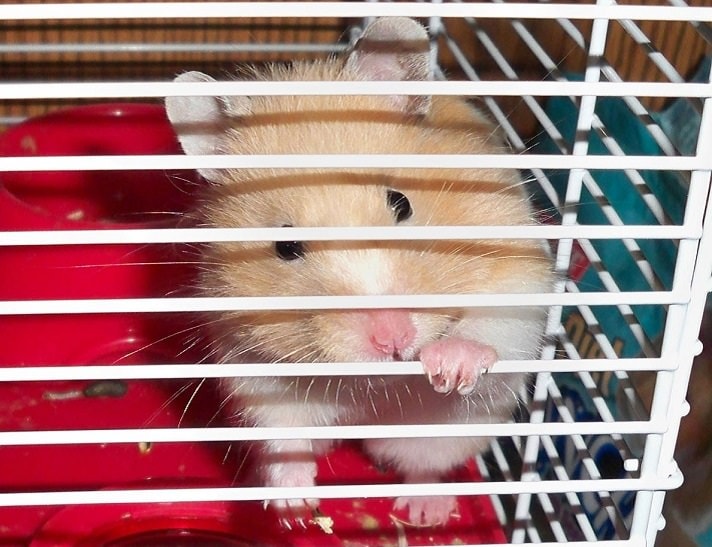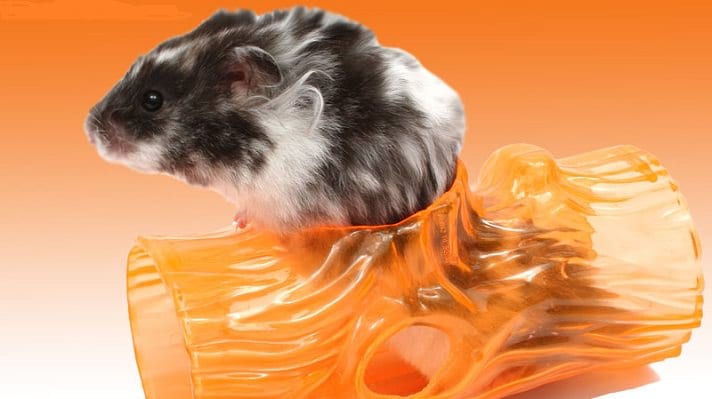Q.
I just bought two longhaired hamsters. I am very scared that they will escape. How good are hamsters at escaping cages?
A.
Congratulations on choosing the best pet! Chances are the pet store informed you that what is usually call “longhaired” and sometimes “teddy bear” hamsters are a special type of Syrian hamster that possesses a gene for long, flowing fur. Apart from the fur, these hamsters share the basic characteristics of all Syrians, which means, of course, that they are solitary and must be housed separately. And that means that if you’re concerned about escapes (and you should be), you’re going to have to go double on your security measures.
Know About Hamster Instincts
Hamsters are master escape artists. In fact, I can’t tell you how many owners I’ve met who have named their hamster “Houdini.” This has nothing to do with how well you care for them. It’s certainly not the case that they are dissatisfied with their homes and with not having to go out and forage for food every night. But instinct is so strong a force that it beats a satisfied belly. That’s why hamsters have exercise wheels. Their inner chemistry tells them they must search far and wide for food despite the fact that it’s right in front of them. A good wheel, that is, one that’s at least 8 inches in diameter and has a solid floor (not bars, those are unsafe) will generally work to “siphon off” the instinctual urge to visit nature’s supermarket every night. For a dwarf hamster, I recommend a diameter of 6.5 inches. Some of the larger dwarf hamsters can handle the 8-inch wheel, but 6.5 inches should be adequate for virtually all.
But sometimes a hamster will neglect his wheel and try to explore the world nonetheless. You’ve probably noticed just from playing with your new pets that it’s very rare that they’ll sit still for even a minute.
Hamsters have the urge to “nose” their way into tight spaces. This is a great survival maneuver in the wild, because hamsters instinctively know that if they find spots that are just a bit wider than their nose to crowd into, it will probably be too small for the bigger creatures in the world that might be chasing them for their own dinner. So tight spaces equal security. You can see that when you observe a Syrian hamster on his own in a room, free to roam (supervised, of course). Watch how the hamster, with a whole wide floor surrounding him, will instead scoot along where the wall meets the floor. That feeling of tight pressure against two sides of his body makes him feel secure. And remember, also, that Syrians live in holes in the ground, so pushing into a tight crevice announces “home, sweet home” to your little friends. That’s why the popular modular homes for hamsters connect with tubes. They’re comforting to wiggle through.
So there’s the problem: You’ve sealed your hamster’s cage up as tightly as you know how. At the same moment your hamster spies a tiny gap where the wire mesh lid meets the aquarium tank, or an almost imperceptibly small opening where a tube connects to a module, thinks there must be something good there, and immediately sets course for it.
Keep Your Hamster Houdini Safe
Be prepared! If you use an aquarium tank with a mesh lid, it’s not enough to put a heavy weight in the middle. That helps, but never underestimate a Syrian hamster’s mighty “Nose Power!” Your hamster will push and push against the corner of the frame until the top lifts just enough for him to squeeze through. Weights must press hard against all corners without cutting off air circulation. Some pet stores sell locking clips that attach to the edges of the top and work very well as long as you remember to use them every time the hamster is in the tank. If you use a modular-type dwelling, with tubes and chambers, remember that hamsters gnaw at things to while away the time and trim their teeth, and the narrow edges where tubes connect seem to be begging to become the hamster’s chew toys. Not only that, but we forget that hamsters become heavier as they mature, and tubes that are suspended between two modules constantly sustain gradually increasing stresses as a result. Whatever the cause, once the tubes begin to separate, any opening is going to look like a passage to a hamster. So check all connectors regularly, make sure they’re strong and secure, and eliminate any that seem flimsy. Put a book or two for support beneath tubes that might become loose due to gravity.
While you’re at it, if your hamster uses a play ball to run in, note that the lids are typically just tiny plastic pegs that fit in slots. When the hamster stops moving because he’s tired, he may amuse himself by gnawing on these pegs. Then, when he moves again, the lid falls open and the hamster wanders. Always have cheap packing tape on hand, and use it generously across the entire area of the lid, where it connects to the rest of the ball. If the circumference of the ball doesn’t seem strong, use tape there too.
Wire cages present a whole other set of challenges. The door latch will always be a focus of attention, and your hamster will try everything he can think of to invoke the magic you use to open it. Here again, you can purchase and sometimes even make your own locking device to be sure his attempts are thwarted. Just don’t rely on the cage door itself! Ordinary large spring clips can provide a large measure of security. The cage’s bars can become bent and even disconnected over time. We may not notice a gap or a loose bar, but when your hamster uses his “nose power” to explore the this pet pen, he surely will. A gap between bars that’s large enough to fit your little finger comfortably through is all a dwarf hamster needs to take flight. You should pay attention to the bars all the time, but make a special point of doing an extra thorough check when you clean your hamster’s cage once every seven days.
So you see, you have every reason to be concerned about your hamster’s escaping, but absolutely nothing should stop you from knowing the joy of caring for them. A while back I offered some of the best tips I’ve come across to locate a lost hamster. But you’ll sleep better at night if you plan ahead for any eventuality by minimizing the hazards: Throw away any mouse traps or poison that might be in storage; seal any gaps in and behind cabinets and appliances as well as around pipes (if you have a built-in kitchen, remember that it’s easier to seal gaps now than dismantle your kitchen if your hamster gets loose); if you have a sump pump or accessible drain in the basement, be sure it’s covered securely; and check whether exterior doors need new weather-stripping to prevent gaps a curious hamster could slip under. Because everyone’s situation is different, it’s not simply about a checklist, it’s a matter of thinking like a hamster.
Yes, you have to be vigilant at all times, and always assume your hamster has found the one opening you’ve missed. But be comforted in the knowledge that your hamster’s urge to take off isn’t a reflection of how you treat it. He’s not trying to get away from you, and would surely regret it if he did. It’s just how your hamster’s made. Remember that the call of instinct is strong, but your loving care is much stronger!
By: Martha Boden
Feature Image: Via PublicDomainPictures/Pixabay
Share:









